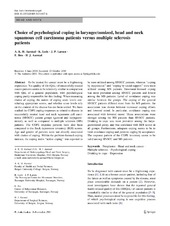| dc.contributor.author | Aarstad, Anne Kari Hersvik | en_US |
| dc.contributor.author | Lode, Kirsten | en_US |
| dc.contributor.author | Larsen, Jan Petter | en_US |
| dc.contributor.author | Bru, Edvin | en_US |
| dc.contributor.author | Aarstad, Hans Jørgen | en_US |
| dc.date.accessioned | 2011-03-11T09:12:49Z | |
| dc.date.available | 2011-03-11T09:12:49Z | |
| dc.date.issued | 2010-11-18 | eng |
| dc.Published | European Archives of Oto-Rhino-Laryngology 1-9 | en_US |
| dc.identifier.issn | 0937-4477 | |
| dc.identifier.uri | https://hdl.handle.net/1956/4566 | |
| dc.description.abstract | To be treated for cancer must be a frightening experience. Yet quality of life (QoL) of successfully treated cancer patients seems to be relatively similar in comparison with QoL of a general population, with psychological coping partly responsible for this finding. When measuring choice of coping, the nature of coping score levels constituting appropriate scores, and whether score levels rely on the context of the disease has not been settled. We have studied the COPE coping responses as related to disease in successfully treated head and neck squamous cell carcinoma (HNSCC) patient groups (general and laryngectomized), as well as compared to multiple sclerosis (MS) patients. The COPE response patterns have also been compared to the Beck depression inventory (BDI) scores. Age and gender of patients were not directly associated with choice of coping. Within the problem-focused coping indexes, the coping index “active coping” was reported to be most utilized among HNSCC patients, whereas “coping by suppression” and “coping by social support” were most utilized among MS patients. Emotional-focused coping was most prevalent among HNSCC patients and lowest among the MS patients. Level of avoidance coping was similar between the groups. The coping of the general HNSCC patients differed most from the MS patients. An association was shown between increased coping efforts and lowered mood. In particular, avoidance coping was associated with lowered mood. These associations were stronger among the MS patients than HNSCC patients. Drinking to cope was most prevalent among the laryngectomized group, and was correlated with BDI scores in all groups. Furthermore, adequate coping seems to be to limit avoidance coping and promote coping by acceptance. The response pattern of the COPE inventory seems to be valid among HNSCC and MS patients. | en_US |
| dc.language.iso | eng | eng |
| dc.publisher | Springer | eng |
| dc.rights | Attribution-NonCommercial CC BY-NC | eng |
| dc.rights.uri | http://creativecommons.org/licenses/by-nc/2.5/ | eng |
| dc.subject | Neoplasms | eng |
| dc.subject | Head and neck cancer | eng |
| dc.subject | Multiple sclerosis | eng |
| dc.subject | Psychological coping | eng |
| dc.subject | Drinking to cope | eng |
| dc.subject | Depression | eng |
| dc.title | Choice of psychological coping in laryngectomized, head and neck squamous cell carcinoma patients versus multiple sclerosis patients | en_US |
| dc.type | Peer reviewed | |
| dc.type | Journal article | |
| dc.description.version | publishedVersion | en_US |
| dc.rights.holder | Copyright The Author(s) 2010. This article is published with open access at Springerlink.com | |
| dc.rights.holder | The Author(s) 2010 | |
| dc.identifier.doi | https://doi.org/10.1007/s00405-010-1417-6 | |
| dc.identifier.cristin | 627300 | |
| dc.subject.nsi | VDP::Medical disciplines: 700 | eng |

